The Reading Section of the IELTS requires a lot of preparation to score a good band. The reading section test is 60 minutes long with 3 or 4 passages of varying levels of difficulty. This sample will help you in your IELTS preparation.
During the preparation, IELTS aspirants go through sample questions and answers to answer well in the exam. One common question in IELTS is the reading passage, ‘Why Does Music Move Us?’ This article will see ‘Why does music move us’ reading answers and the right way to approach different types of questions.
Why Does Music Move Us?
Part 1
A lot of things leave a lasting impact on our brain. Brain stimuli respond to various actions we perform daily. A very simple example is when we get excited to see a car chase scene in a movie, even if we know it is choreographed.
Sound is waves of pressure transmitted through air, liquid, or solid. Music is just another way of sending sound vibrations to the ears, but it is pleasurable to hear.
Now that the basics of the topic are mentioned, we can proceed by putting some light on the history of the topic. It makes an impact on the reader as you have information from the origin, making the article engaging.
A Little History of Music? – Part 2
There can be many reasons why music is pleasurable. Humans could have lived without music, but we did make it. Our ancestors could guess that when one is taught poetry or certain speech, but they tend to forget it. On the other hand, humans tend to remember the rhythmic music they made for years. These are all parts of language learning.
The evolution of the modern human mind is closely related to the evolution of languages. Through language, we can pass on ideas and cultures to the next generation.
Whether it be foot-tapping or a bird chirping, humans enjoy the slightest of music from nature. And these music patterns remain in our memory for years. If one uses the same technique to convey a message or by heart a speech, it is easier. This led humans to create music. Today, all parts of the world create music, and it has become a universal skill.
Also Read:- Describe A Person/Friend Who is a Good Leader: IELTS Cue Card Sample Answer
The Technical Aspect – Part 3
Music is soothing and groovy, but what happens to our body? Which part of the body is affected; such technicalities have been explained below.
Every time we listen to music, our brain responds to the same music differently. Scientists have been still working on the reason behind this, many conclusions have been made to justify it. There is anecdotal evidence suggesting the pleasing behaviour of music to our ear and brain encourages movement of our body.
Music is built to stimulate pleasure in our brain, especially the orbitofrontal cortex. This is a part of the brain located directly behind the human eyes and extends up to the midbrain. The amount of brain tissue activation depends on how well we enjoy the song.
Why is Music Pleasurable? – Part 4
Music makes many parts of our brain go into a soothing state of calmness or even excitement. Music can internally give a spine-tingling response to our body, relax our muscles, or affect blood pressure, hormones and heart rate. It can also lead to external body changes like goosebumps or tears.
People at first thought that music was created through rhythmic movements, like foot tapping. Strong evidence suggests that we are sensitive and aware of the movements of others’ bodies because similar parts of the brain activate when familiar movements are made or observed.
For example, the motor areas of professional dancers’ brains show much more activation when they watch other people dance compared to people who don’t dance at all.
Speculation on Why Music is Pleasurable – Part 5
This kind of disclosure has led to a great deal of speculation regarding mirror neuron cells found in the cortex, the brain’s main part of the central processing unit of the brain, that activates when a person is performing an action and watching someone else do it.
Strong evidence suggests that sensory encounters are also motor experiences. Music and dance are very particularly pleasurable activators of these sensories and motor circuits. So, if you’re watching someone else dance, your brain areas activate; unconsciously, you are seeing, planning, and predicting how a dancer would move based on what you would personally do.
So, the evidence indicates that humans like watching others in motion and being in motion themselves; adding music to the mix may be a pinnacle of honour.
How Music Helps Movement? – Part 6
In fact, music can actually help improve your movement skills by improving your timing, coordination and rhythm. For example, take the Brazilian folk art, Capoeira which is a dance masquerading seen as a martial art or vice versa.
Many of the moves in that fighting style are choreographed, taught, and practised, along with music, which makes the participants more adept by giving them the pleasure of the music as well as from performing the required movement or action.
IELTS Preparation Questions and Answers
Now we’ll look into the answers of the reading passage, ‘why does music move us?’ to see the type of questions we can expect and how to approach them.
The questions can be of different types such as Multiple Choice QUESTIONS (MCQs), Fill in the Blanks, True or False, Yes, No, or not given, etc.
True or False
#1 Sound waves are rarely transmitted through a solid medium.
Answer: False
#2 Professional dancers brain responds more strongly compared to others when they watch others dancing
Answer: True
#3 Does music affect our movements?
Answer: True
Yes, No, or Not Given
#1 Music and the evolution of languages are related
Answer: Not given
#2 Brain’s activation power depends on how loud the sound of music is
Answer: No
#3 Whole-body responds differently to music
Answer: Not given
#4 How was music invented
Answer: Not given
#5 Our brain responds in the saw way to the same type of music and differently for different types of music forms
Answer: No
#6 Is our timing affected by music?
Answer: Yes
Subjective
#1 How is music pleasurable to humans?
Answer: Due to the specific pattern of the sound waves, music is a pleasure to human ears.
#2 Name the common external actions that occur while listening to music
Answer: Goosebumps and tears
Fill in the blanks
#1 Music helps in improving __________ and __________
Answer: rhythm and coordination
MCQ
#1 Which of the following is incorrect. Listening to music?
- Relaxes muscles
- Affects blood pressure
- Increases heart rate
- Makes hand function
Answer: Hand function
#2 Which part of the brain is affected while listening to music?
- orbitofrontal cortex
- Stem
- Cerebrum
- Cerebellum
Answer: orbitofrontal cortex
Few Tips to Follow while Doing the Reading Passage for the IELTS Exam
Most of the candidates preparing for IELTS believe that the reading section is hard. Sometimes, the questions can be difficult; but you can score a good band with some right and effective tips. Below are such tips for both preparing for IELTS
#1. Read the questions first and then the text
#2. Don’t focus much on the information
#3. Concentrate on what’s in the Passage
#4. Re-read the passage when in doubt
#5. Don’t Emphasise on Vocabulary
#6. Do not Memorise Everything
#7. Focus on keywords and mark them
#8. Focus on important points
#9. Do not answer what’s known to you; answer based on only what is given
#10. Manage your time well
Also Read:- Also Read: Describe an Interesting Animal Dog: A Cue Card Topic for the IELTS Exam
Prepare with IELTS NINJA
You should note that the questions asked can be of different types based on the vocabulary, title, and themes. With our IELTS reading practice test with answers, we hope that you got clear information on preparing for the reading section of IELTS, how to answer, tips to prepare well and perform efficiently.
Conclusion
Continue reading IELTS Ninja’s numerous blogs and articles. It will help you gain a clear perspective on how to score a good band. For more help, IELTS Ninja‘s personal mentors with years of experience will help you in every step towards your dream of further studies abroad.
Expert Mentors, our Ninjas will help you solve your doubts, keep track of your progress, and help improve in weak areas. Don’t miss the free demo class and experience the teaching methodology of IELTS Ninja before making the next-best decision to join them. For more details, visit the IELTS Ninja website now.










